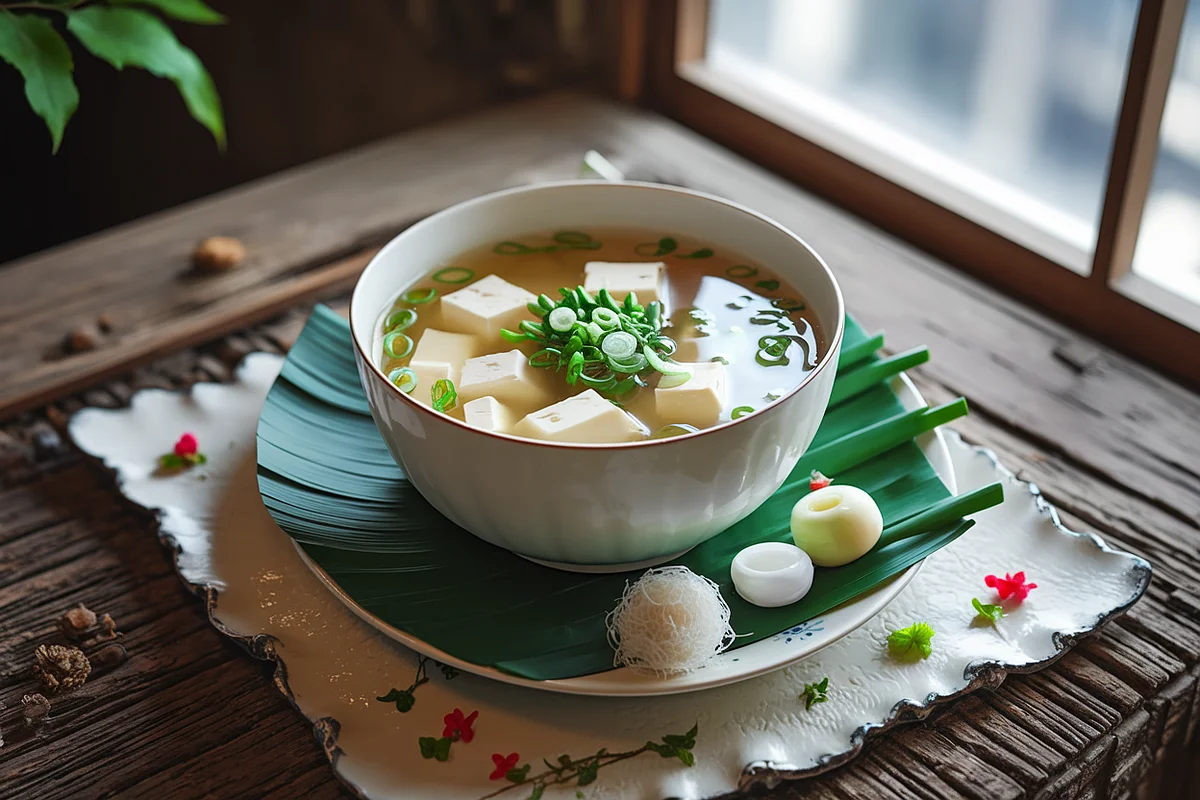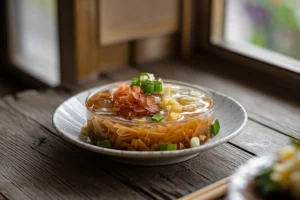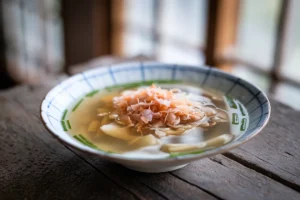Japanese clear soup is a beloved dish in Japanese cuisine, characterized by its light, flavorful broth. It’s a simple yet elegant dish that often appears in Japanese restaurants, especially in hibachi-style settings. In this article, we’ll explore the components of this delicate soup, its variations, health benefits, and how you can make it at home. We will also discuss its historical significance and answer common questions about this popular dish.
Introduction
Japanese clear soup, often referred to as Osumashi or Hibachi clear soup, features a broth-based composition made with a blend of dashi, vegetables, and minimal seasoning. It’s treasured for its simplicity and clarity in both flavor and appearance. Unlike rich or creamy soups, clear soup focuses on highlighting the natural essence of its ingredients, making it a healthy option for many.
A crucial component of this soup is the dashi broth, which forms the base of many traditional Japanese dishes. Dashi provides a rich umami flavor, balancing the soup’s subtle ingredients. Other elements, like carrots, mushrooms, and soy sauce, work together to enhance its taste.
Learn more about Dashi in Japanese Cuisine, an essential ingredient that forms the soul of the dish. You can also read about the benefits of ginger and garlic, two commonly used ingredients, at Health Benefits of Ginger and Garlic.
History of Japanese Clear Soup
Japanese clear soup has roots stretching back centuries, evolving alongside Japan’s rich culinary traditions. Originally, the dish served as a staple in traditional Kaiseki cuisine, a multi-course meal designed to showcase the seasonality and presentation of ingredients. Chefs often presented clear soups like Osumashi between courses to cleanse the palate, offering a light and simple contrast to more complex flavors.
As time passed, different regions began to adapt the recipe by incorporating local ingredients and varying preparation techniques. Today, people enjoy clear soups in both casual and formal settings, and many Western hibachi restaurants have popularized their own versions of this traditional dish.
Main Ingredients in Japanese Clear Soup
The ingredients of Japanese clear soup are simple, yet each one plays a vital role in building the dish’s distinctive flavor profile. Let’s take a closer look at these components:
Dashi: The Essential Broth Base
Every Japanese clear soup relies on a dashi base, a stock prepared from kombu (kelp) and katsuobushi (dried bonito flakes). Dashi brings a subtle umami flavor to the dish, elevating its overall taste. Unlike Western broths, which often simmer for hours, dashi comes together quickly and results in a lighter, more delicate flavor.
How Dashi is Made
To make dashi, you soak kombu in water and bring it to a gentle simmer. After removing the kombu, add the bonito flakes and let them simmer briefly before straining. This liquid holds the essence of umami and serves as the foundation for many Japanese dishes, such as miso soup and ramen.
Importance of Dashi in Japanese Cuisine
Dashi isn’t limited to just soups; it’s a critical element in sauces, dressings, and marinades. This versatile broth is key to the umami taste that characterizes so much of Japanese cuisine. By mastering dashi, you gain access to a wide range of Japanese recipes.
Vegetables: Common Additions
The vegetables chosen for Japanese clear soup impart flavor without clouding the broth. Common vegetables include:
- Carrots: Contribute sweetness and color to the soup.
- Onions: Add depth and a touch of sharpness.
- Mushrooms: Bring an earthy flavor that complements the umami notes of the dashi.
- Scallions: Garnish the soup and provide a mild onion flavor.
Soy Sauce: Adding Umami
A small amount of soy sauce often enhances the umami in the broth without overwhelming the delicate flavors of the dashi and vegetables. Soy sauce also adds a bit of color to the clear broth.
Ginger and Garlic: Flavor Enhancers
Both ginger and garlic contribute aromatic and warming qualities to the soup. Ginger brings a subtle spiciness and is known for its anti-inflammatory benefits, while garlic, though used sparingly, adds savory depth.
Protein Options
Though you can enjoy the soup without meat, many variations incorporate proteins like chicken, beef, or tofu, each adding its own distinct flavor:
- Chicken: Light and mild, chicken works well with the soup’s gentle broth.
- Beef: Adds richness and is popular in hibachi-style soups.
- Tofu: A vegetarian option that provides texture without overwhelming the broth’s delicate taste.
Variations of Japanese Clear Soup
There are several variations of Japanese clear soup, each unique in ingredients and preparation:
Osumashi (Traditional Clear Soup)
Osumashi represents the traditional version of Japanese clear soup. It consists mainly of dashi, vegetables, and light seasoning. This soup often appears during formal meals in Japan, such as tea ceremonies or holiday celebrations. The flavor is subtle, with the presentation emphasizing thin slices of vegetables and proteins floating in the clear broth.
Hibachi Clear Soup
A popular Western adaptation, hibachi clear soup features a meat-based broth (usually chicken or beef) and includes vegetables like onions, carrots, and mushrooms. This version has a slightly more robust flavor than Osumashi, due to the long simmering of the meat-based broth.
Japanese Onion Soup
In this variation, onions take center stage, giving the soup a pronounced onion flavor. Japanese onion soup typically simmers onions over a long period, releasing their natural sweetness into the broth. You can often find this soup served as a starter in hibachi restaurants across the U.S.
Miyabi Soup
Miyabi soup blends both beef and chicken broth, resulting in a richer, more complex flavor. Often garnished with green onions, mushrooms, and sometimes crispy fried onions, Miyabi soup offers a distinct texture and taste profile compared to other clear soups.
Health Benefits of Japanese Clear Soup
Not only does Japanese clear soup delight the palate, but it also delivers numerous health benefits:
- Low-Calorie and Nutrient-Dense: Primarily consisting of broth and vegetables, the soup offers a low-calorie option packed with essential nutrients.
- Rich in Vitamins and Minerals: Vegetables like carrots and onions provide vitamins A and C, potassium, and fiber.
- Gut Health Benefits: Ingredients such as soy sauce and sometimes miso contribute probiotics that support gut health.
- Anti-inflammatory Properties: Ginger and garlic are known for their ability to reduce inflammation and boost the immune system.
How to Make Japanese Clear Soup: Step-by-Step Recipe
Here’s a simple recipe for making Japanese clear soup at home:
Ingredients
- 4 cups dashi (or chicken broth for a meat-based version)
- 1 medium carrot, thinly sliced
- 1 small onion, thinly sliced
- 2 mushrooms (shiitake or button), thinly sliced
- 1 tsp soy sauce
- 1-inch piece of ginger, thinly sliced
- 1 clove garlic, minced
- Scallions for garnish
- Protein of choice (optional: chicken, beef, or tofu)
Instructions
- Prepare the Broth: If using dashi, follow the steps to make it from kombu and bonito flakes. For a meat-based version, substitute with chicken broth.
- Simmer Vegetables: Add carrots, onions, mushrooms, ginger, and garlic to the broth. Simmer for 20 minutes or until the vegetables are tender.
- Season the Soup: Stir in the soy sauce and taste, adjusting the seasoning as needed.
- Add Protein: If adding chicken, beef, or tofu, simmer until the protein is fully cooked.
- Serve: Strain the soup to maintain clarity and serve with scallions for garnish.
FAQs about Japanese Clear Soup
What is the difference between Japanese clear soup and miso soup?
Miso soup uses fermented soybean paste, resulting in a cloudy appearance and a stronger flavor, whereas Japanese clear soup features a light, transparent broth.
Can Japanese clear soup be made vegetarian or vegan?
Yes, by using vegetable broth instead of dashi or chicken broth, and by substituting tofu for meat.
How long does it take to make Japanese clear soup?
The entire process, from simmering the vegetables to adding the protein, takes around 30 minutes.
What are the best vegetables to use in clear soup?
Commonly used vegetables include carrots, onions, mushrooms, and scallions, but you can also experiment with zucchini, daikon, or bok choy.
Can I store Japanese clear soup for later?
Yes, you can refrigerate the soup for up to 3 days. For best results, strain the broth and store it separately from the vegetables and proteins.
Conclusion
Japanese clear soup provides a perfect balance of flavor, health benefits, and simplicity. Whether you enjoy the traditional Osumashi or the more robust hibachi-style clear soup, this dish appeals to everyone with its light, nourishing qualities. Understanding the key ingredients and variations of this soup will allow you to bring a touch of Japanese cuisine into your own kitchen.



